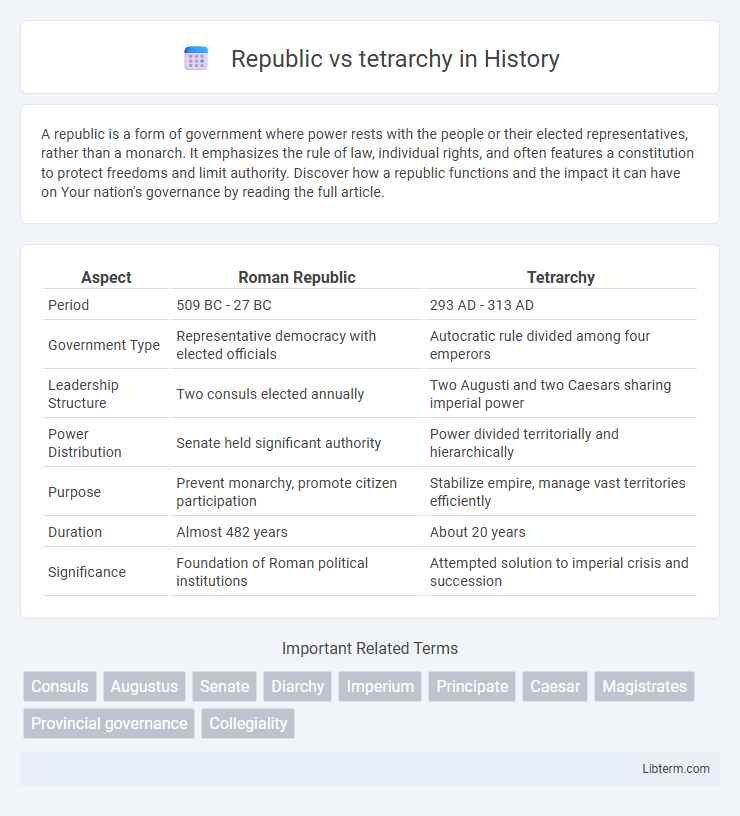A republic is a form of government where power rests with the people or their elected representatives, rather than a monarch. It emphasizes the rule of law, individual rights, and often features a constitution to protect freedoms and limit authority. Discover how a republic functions and the impact it can have on Your nation's governance by reading the full article.
Table of Comparison
| Aspect | Roman Republic | Tetrarchy |
|---|---|---|
| Period | 509 BC - 27 BC | 293 AD - 313 AD |
| Government Type | Representative democracy with elected officials | Autocratic rule divided among four emperors |
| Leadership Structure | Two consuls elected annually | Two Augusti and two Caesars sharing imperial power |
| Power Distribution | Senate held significant authority | Power divided territorially and hierarchically |
| Purpose | Prevent monarchy, promote citizen participation | Stabilize empire, manage vast territories efficiently |
| Duration | Almost 482 years | About 20 years |
| Significance | Foundation of Roman political institutions | Attempted solution to imperial crisis and succession |
Introduction to Republics and Tetrarchies
Republics feature a form of government where power resides with elected representatives and an organized constitution, emphasizing citizen participation and legal frameworks. Tetrarchies divide authority among four rulers, often to maintain order and manage large territories through shared leadership, exemplified by the Roman Empire's governance in the late 3rd century AD. Both systems reflect distinct approaches to political power distribution, with republics focusing on collective decision-making and tetrarchies on power-sharing among multiple leaders.
Historical Origins of the Republic System
The historical origins of the Republic system trace back to ancient Rome in 509 BCE, following the overthrow of the Roman monarchy and the establishment of a government characterized by elected representatives and a complex constitution. This system emphasized checks and balances through institutions such as the Senate, popular assemblies, and magistrates, promoting civic participation and accountability. In contrast, the Tetrarchy, instituted by Emperor Diocletian in 293 CE, divided imperial power among four rulers to address administrative challenges of the vast Roman Empire, marking a shift from republican principles to autocratic governance.
Emergence and Structure of the Tetrarchy
The transition from the Roman Republic to the Tetrarchy marked a significant shift in governance, with the Republic's senatorial rule giving way to Diocletian's innovative system of power-sharing established in 293 AD. The Tetrarchy divided the Roman Empire into four regions, each ruled by either an Augustus or a Caesar, creating a hierarchical and regionalized command structure designed to improve administrative efficiency and military defense. This structural reorganization emerged from the Republic's need to manage vast territorial expansions and internal instability, epitomizing the move towards centralized imperial authority with a clear division of responsibilities.
Key Principles of Republican Governance
Republican governance centers on the principle of popular sovereignty, ensuring that power emanates from the citizens through elected representatives. It emphasizes the rule of law, where laws govern actions rather than individuals, providing checks and balances to prevent authoritarian rule. The structure fosters political participation, civic responsibility, and accountability, contrasting with the Tetrarchy's division of power among appointed rulers aimed at administrative efficiency and military control.
Power Distribution in a Tetrarchic System
The tetrarchic system divides power among four rulers, each overseeing a distinct region of the Roman Empire, creating a decentralized governance model. This structure contrasts with the centralized authority found in the Roman Republic, where power was concentrated mainly in the Senate and elected magistrates. By distributing administrative control among two senior emperors (Augusti) and two junior emperors (Caesars), the tetrarchy enhanced regional stability and quick decision-making across vast territories.
Decision-Making Processes Compared
The Roman Republic operated through a complex system of checks and balances involving the Senate, popular assemblies, and elected magistrates, ensuring collective decision-making and civic participation. In contrast, the Tetrarchy centralized authority among four rulers, each with distinct territorial control, streamlining decisions but reducing broad-based political involvement. This shift from republican deliberation to autocratic coordination marked a fundamental transformation in governance and administrative efficiency.
Impact on Political Stability
The Roman Republic's political stability was challenged by internal conflicts and power struggles among the Senate, consuls, and popular assemblies, often leading to civil wars and reforms. In contrast, the Tetrarchy introduced by Emperor Diocletian aimed to stabilize governance by dividing power among four rulers, effectively reducing individual dominance and providing more localized control. This system temporarily enhanced political stability by creating clear succession plans and reducing internal conflicts, although it eventually broke down due to competing ambitions among tetrarchs.
Republic vs Tetrarchy: Social Dynamics
The Roman Republic was characterized by a complex social hierarchy involving patricians, plebeians, and slaves, with political power largely held by the aristocratic Senate. The Tetrarchy, established by Emperor Diocletian, restructured the Roman Empire into four rulers to stabilize control and manage diverse populations across vast territories, shifting focus from traditional Senate authority to imperial bureaucracy. This transformation altered social dynamics by centralizing power, reducing aristocratic influence, and increasing administrative roles for equestrians and local elites.
Evolution and Legacy in Modern Governance
The Roman Republic established foundational principles of representative democracy and checks and balances, influencing modern governance structures by emphasizing citizen participation and legal frameworks. The Tetrarchy introduced a system of power-sharing and administrative division to stabilize imperial governance, inspiring contemporary federalism and decentralized governmental models. Both systems contributed to evolving concepts of authority distribution and institutional continuity in political systems worldwide.
Conclusion: Lessons from Republics and Tetrarchies
Republics demonstrate the power of representative governance and civic engagement in sustaining political stability, while tetrarchies showcase the benefits of power-sharing to manage expansive territories effectively. The combination of democratic principles found in republics and structured authority in tetrarchies offers valuable insights for modern governance systems. Balancing citizen participation with decentralized administration emerges as a key lesson from both models to enhance political resilience and adaptability.
Republic Infographic

 libterm.com
libterm.com